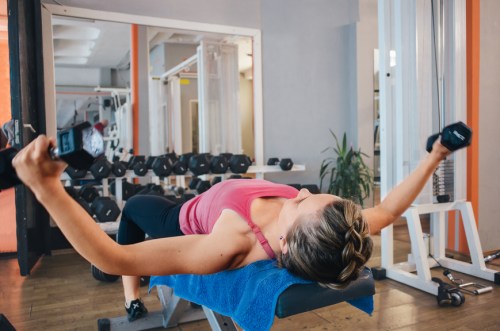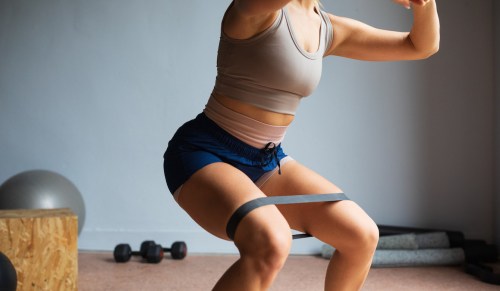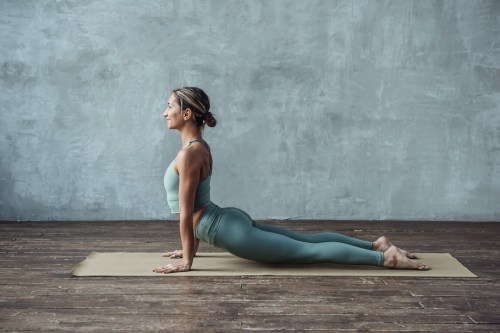Weight lifting is one of the best way to drastically tend your physique—and that goes for anyone, of any gender, with any experience (if you know where to start). Chest exercises can improve everything from posture to upper body range of motion. Still, if the idea of getting beneath a 45-pound bar that’s then loaded with plates intimidates you, you still have options. Namely, chest flies.
Experts in This Article
certified functional strength coach and founder of BodyRox
What are chest flies?
Chest flies are an upper body exercise that help strengthen the chest, shoulders, and core by lowering weights out and down toward the sides before “flying” them back up to the starting position (more on that, below). “Chest flies are typically done [laying face up] on a mat or bench with dumbbells, but can also be performed standing or kneeling upright with a cable machine,” says personal trainer and WW Digital 360 coach Bianca Vesco. (Think: Cable crossovers.)
Although there are several ways to perform chest flies, Orangetheory coach Erin De Groot, who is involved in designing OTF workouts and managing the Orangetheory Live HQ studio, says that most people (especially beginners) fare best on a bench or the floor, with dumbbells in hand, as it puts the primary focus on the fly, as opposed to the full body, which other variations require.
The benefits of chest flies
Before getting into how to perform chest flies, let’s go over why you’ll want to in the first place. According to De Groot, dumbbell chest flies are one of the best chest strengtheners and pec builders around—and they’re infinitely adjustable (thanks to weight selection), making them accessible for all.
“Whether you’re looking to increase muscle mass, improve your posture, or even improve your push-up game, chest flies can give you the results you’re looking for,” she says, noting that that’s exactly why the movement is occasionally incorporated into the floor portion of Orangetheory classes.
The reason chest flies are so beneficial is because of their mechanics. “The movement opens the chest and shoulder muscles and helps promote strength in the upper part of the back, both areas that in today’s world of prolonged sitting, hunching, and screen-use tend to suffer, contributing to poor posture,” De Groot says. “Requiring you to ‘squeeze’ the shoulder blades together (known as scapular retraction), chest flies are a key component to help you stand a little taller.” What’s more, she points out that, when done properly, chest flies can also support a stronger and more stable core—“Hello, less back pain!” she says.
How to perform chest flies
Note: Whether you’re performing dumbbell chest fliest on a bench or the floor, the sequence remains the same.
1. Select your weights
Remember: less is more. Focus on what you can safely lift for at least eight to 10 reps, and two to three sets.
2. Lie down
With one dumbbell in each hand, lie flat on your back, with your gaze up and chin untucked.
3. Begin the lift
Extend your arms above your head making sure your dumbbells are facing each other.
4. Lower slowly
With a slight bend in each elbow—creating a C shape—to slowly lower your weights out and down toward your chest.
5. Raise to start
From there, return to the top of the movement by maintaining the C shape while pressing the weights back up toward the sky so that your palms are again facing.
Watch the video to see how to do chest flies from the floor:
Mistakes to avoid with chest flies
As with most weightlifting exercises, there are a few things you want to keep in mind while performing chest flies to maintain your safety.
1. Going to heavy
“It is super important to choose a weight that allows you to lower with control, maintaining a bend in both elbows,” says Centr trainer Alexz Parvi. Ultimately, you don’t want to choose too much weight, which could force your arms lower than your chest when extended out to the side, as that will alter the effects of the movement and could even lead to injury.
Expanding on that, Vesco says not to be afraid (or ashamed) of a lighter lift. “You want a weight that feels challenging but doesn’t make you tense up and lose your neck because your shoulders are in your ears,” she explains. “It should feel good! Because flies are designed for a smaller muscle group, generally lighter is better so you don’t end up recruiting the same muscles you use for a chest press or injuring yourself.”
2. Letting your form lapse
From a form perspective—and tacking on to what Vesco mentioned above—De Groot says that it’s important to be mindful of how bent your elbows are. “Be sure to keep just a slight bend in your elbows,” she says. “The more they bend, the more you’ll turn your chest fly into a chest press.”
3. Moving too fast
“Chest flies will give you better results when you slow down the movement and keep tension in your muscles longer,” De Groot says. “Try three counts to lower the weights, and one to two counts to bring them back up.”
4. Forgetting to breathe
When incorporating a new movement into your weightlifting routine—or even when upping your weight—it’s common to forget to breathe. As such, Parvi says to make sure to tune into your breath throughout your chest flies, making sure to inhale while lowering and exhale while raising. Doing so will help you find cadence with the movement.
Although there is absolutely a right and wrong way to perform chest flies—not to mention a number of variations between dumbbells and cable machines—Vesco reiterates that the best way to perform the popular movement is in the manner that makes the most sense for you and your goals.
“I am a big fan of using dumbbells over machines in general because they require a different kind of effort from your body,” she shares, noting that they can also lead to more overall full-body strength over time. “You have to work harder to stabilize and will recruit more muscles with dumbbells because you are not attached to something stable like you are on a cable machine. That being said, if you are focusing solely on chest strength and want to pull more weight in a safer environment, cables are the way to go. There is certainly no right or wrong answer here, only the variation that feels best in your body.”
Oh hi! You look like someone who loves free workouts, discounts for cutting-edge wellness brands, and exclusive Well+Good content. Sign up for Well+, our online community of wellness insiders, and unlock your rewards instantly.
Sign Up for Our Daily Newsletter
Get all the latest in wellness, trends, food, fitness, beauty, and more delivered right to your inbox.
Got it, you've been added to our email list.











